Whether we are talking about a typical school band, a marching band, a concert band, a jazz band, or on another level, a professional orchestra, there are three main different groups of instruments in a band:
- brass
- woodwind
- percussion
But, what instruments are in a band?
If we only consider typical school bands and marching bands, the following instruments are typically played in a band:
Band Instruments List
- WOODWIND
- Clarinets
- Flutes
- Saxophones (Alto, Tenor, and sometimes Baritone)
- Piccolos
- Oboes
- Bassoons
- BRASS
- Trombones
- Trumpets
- Tubas
- French Horns
- Baritones
- PERCUSSION
- Snare Drums
- Bell Kit
- Bass Drums

Such instruments can form different types of bands. And the type of instruments present in each will differ greatly, depending on the type of band itself, the number of players, and their level.
In typical school bands, the number of instruments will vary depending on how many students make it. Also, depending on the level of the band itself, we are talking about an elementary school, middle school, or high school band.
Marching bands are the type of band that will normally hold a higher number of instruments, as some might be composed of hundreds of players.
If we take a level up in terms of performance and professionalism and consider also orchestras, then not only the amount of instruments increases significantly, but also the type of instruments and sometimes their complexity in playing them. Orchestras, for example, take one more family of instruments that aren’t commonly seen in school bands, which are the strings section of instruments.
How Many Instruments Are in a Band?
The number of instruments that are in a band, will depend on the size of the band and if it is a typical school band or a concert band.
Normally, the number can go up to 14 band instruments, categorized into three different categories or groups: woodwind, brass, and percussion.
The Three Categories of Instruments in a Band
To get a closer look at the most common type of instruments that are presented in a school or concert band, let’s dive into them and know a bit more about each of them, following the three types of instrument categories that we’ve mentioned above: woodwind, brass, and percussion.
Woodwind Instruments

Belonging to the broader family of wind instruments, woodwinds make a sound when a player blows air into a mouthpiece which then generates a reed to vibrate – a reed is a thin piece generally made of wood or cane.
These pieces are small and are clamped to a mouthpiece at the top of the instrument which vibrates when air is blown between the reed and the mouthpiece itself. This reed vibration is exactly their main distinction when compared to other types of the broader family of wind instruments. They can be further divided into flutes and reed instruments, the main distinction between them is the sound each of those instruments produces.
Bands commonly have the following type of woodwind instruments: flutes, clarinets, saxophones, bassoons, and, sometimes piccolos and oboes.
Despite their name suggesting otherwise, currently, woodwind instruments aren’t made of wood only. The name was given as in the past, wood was the only material used to make these instruments. Nowadays, different materials can be used to produce woodwinds, namely: wood, silver, cane, brass, plastic, a combination of those, or sometimes even platinum and gold. A common example that is given to understand this fact is the saxophone itself – despite being made of brass, it is considered a woodwind as it comprises a reed to produce its distinctive sound. A typical woodwind section of a band or even of an orchestra regularly consists of one contrabassoon, three bassoons, a bass clarinet, an English horn, three oboes, a piccolo, and three flutes. Once again, this always varies in terms of which band we are talking about.
In terms of sounds that each instrument makes, smaller woodwinds will play higher notes and on the contrary, larger instruments play the lower notes characterizing their lower sounds. So, from the lowest sounding instruments to the highest, you have:
- bassoons
- clarinets
- oboes
- saxophones
- flutes
- piccolos
Bassoons
The bassoon is a big double-reed instrument with a lower sound than the other woodwind instruments. It is played by holding it upright and also blowing via its double reed, which is affixed to a tiny curved tube called a bocal. Their unique bend in the pipe makes it possible for musicians to play it pleasantly. The air travels down the tube and after that makes a U-turn and rises as well as out the top. It is estimated that if it was straight, the bassoon would be around 9 feet long.

Like the oboe, the bassoon makes use of a dual reed, which is fitted into a rounded metal mouthpiece, and you utilize both hands to press on the keys to open and also close the holes and alter the pitch. In orchestras, there are 2 to 4 bassoons and they have a similar variety to that of the cello. Bassoons usually play lower harmonies, but you will certainly occasionally hear their hollow low notes featured in a tune.
Saxophone
The saxophone belongs to the woodwind family and was invented in 1846 to integrate the power of a brass instrument with the flexibility of a woodwind instrument. Such flexibility makes the saxophone a lot of fun to play and it’s an instrument that you could see being integrated into the wood instrument sections of all sorts of bands, being recurrently seen as a notable member of, for example, jazz bands. Quite popular both with beginners saxophone players as well as more professional and famous musicians.
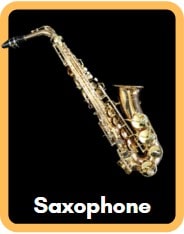
Conically shaped, the saxophone is the only woodwind instrument constructed from brass. Although it is found just occasionally in the symphony orchestra, it is considered a participant of the woodwind family since it has a single reed like the clarinet.
Clarinet
The clarinet is also a member of the woodwind family and is capable of playing both loud and soft, with several different tones. Exactly because of that, it’s used in practically every style of music today. Made mostly from wood, the clarinet produces a fluid sound when air is blown between a single reed and also the mouthpiece. By pressing metal keys with the fingers of both hands, the player can play various notes extremely rapidly.
The clarinet could easily be misinterpreted as an oboe if it wasn’t its mouthpiece, which uses a single reed. The way it’s played is the same as an oboe: by holding it upright, blowing through the reed, and also using your hands to alter the pitches by opening and closing the keys with your fingers.

Clarinets can be found in a variety of different dimensions, and also the common B-flat clarinet is just over 2 feet long. Some music works call for the clarinetist to play several kinds of clarinets in the same piece. For example, in orchestras, their 2 to 4 clarinets can play both melodies and harmonies, having a distinctive sound in their lower notes, opposing to the upper part of the array, which can make powerful and bright sounds.
Oboe
As just mentioned, the oboe is similar to the clarinet in numerous ways. Both have metal keys that can create several notes and are made from wood. Unlike the clarinet, the oboe does not have a mouthpiece, yet has two reeds tied together. By positioning them in between a player’s lips and blowing air, the reeds vibrate and end up generating a sound.
In terms of form, it is a 2-foot long black cylindrical tube, with metal keys covering its openings. Its mouthpiece utilizes a double reed, that vibrates when blown. This vibration of the reed makes the air inside the oboe move, and, therefore, develop sound. To play it, hold the oboe upright, blow through the dual reed in your mouth, as well as make use of both hands to press down on the keys to open as well as close the holes, and also modify the pitch.

In an orchestra, there are usually 2 to 4 oboes responsible for producing a wide variety of pitches, from haunting sounds to warm, velvety smooth notes, making the sound of such instruments very remarkable.
Flute
The flute is one of the oldest instruments participating in the woodwind family. The flute is usually credited with playing gorgeous melodies and with its adaptability and unique high pitches you can hear those sounds in various types of musical groups, from jazz to classical music, marching bands, and also Latin music or other songs from all over the globe.

It is the eldest of all instruments that produce pitched sounds (not simply rhythms) and was originally made from wood, stone, clay, or hollow reeds like bamboo. Modern flutes are now constructed from silver, gold, or platinum. A common flute is a little over 2 feet long and is usually highlighted when playing the melody.
It’s one of the most popular band instruments among beginners.
Check our expert review of some of the best flutes for beginners in the market nowadays.
You play the flute by holding it sideways with both hands and also blowing through a hole in the mouthpiece, much like blowing across the top of a bottle. Your fingers open as well as shut their keys, resulting in changing the pitch. It appears like a narrow tube with a row of holes covered by keys along one side. The player blows air throughout the tiny opening in the mouthpiece to produce a sound that can be either soft and smooth or high and piercing.
Piccolo
Piccolos, which means “small” in Italian, are shorter variations of the flutes, roughly half of their dimension, and play the highest notes of all the woodwinds. It is generally made from silver or timber. In the orchestra one of the flute members will likewise play piccolo if that instrument is called for. The high piping sound of the piccolo is also listened to in standard drum corps and marching band music.
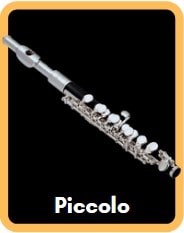
Sounds of Each Wind Instrument in a Band
How are the sounds made through each of those wind instruments? Starting with the larger ones: bassoons and oboes are sounded by forcing an airstream directly from a flexible strip material, whether metal or cane, to pass through a double-reed and then reach a column of air for producing a sound vibration.
That is quite similar to what is done for example for clarinets and saxophones (also known as “reed pipes”) but instead of a double-reed, in these cases, we are talking about one reed only. In the case of the flutes, the sound is made through a direct and narrow stream of air that reaches the edge of a hole in a cylindrical tube.
The sounds made in all of the woodwind instruments are also dependent on the fingers or keys pressed by the player which directly opens the holes, enclosing or shortening the air columns that pass in the instrument which then ends up in higher or lower sounds.
Brass Instruments
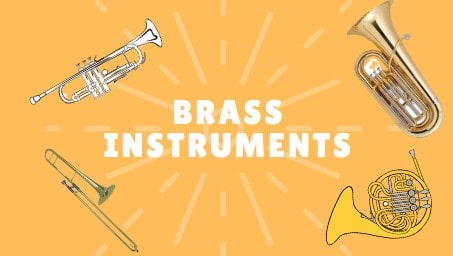
The brass area of the band is made up of instruments such as trumpets, trombones, tubas, and occasionally the French horn. All of these instruments are played making use of lip vibration in conjunction with either valves or a slide. The typical band will certainly have several trumpets, sustained by trombones, and only a handful of tubas as well as French horns.
Brass family instruments create their unique sound when the player blows air with the lips via a cup or channel-shaped mouthpiece. The mouthpiece helps to intensify the humming of the lips, which then creates the sound. To generate higher or lower pitches he or she can change the opening between his/her lips, and produce a series of pitches representing the overtone series.
Similar to the woodwind family of a band, although their early ancestors were mainly constructed from wood, tusks, horns, or shells, today’s modern instruments are made entirely of brass. This group of instruments can date back its origins back to French horns, searching horns, and also army bugles.
This section of a band or orchestra got its name precisely due to the fact of being constructed from brass. They can play louder than any other instrument in a band or orchestra and can also be heard from afar. In terms of form, brass instruments are long pipes that widen at their ends right into a bell-like shape. The pipes have been bent as well as turned into various shapes to make them much easier and more comfortable to hold and play.
One of the distinctions between the brass and the woodwind family is that brass player, despite that also utilizing their breath to create sound, don’t blow it into a reed, but instead, vibrate their lips by buzzing against a metal cup-shaped mouthpiece.
The mouthpiece then helps to intensify the buzzing of the lips, which results in a sound. The majority of brass instruments have valves attached to their lengthy pipes; the valves look like buttons. When you press down on the valves, they open up as well as close various parts of the pipe. You transform the pitch and sound by pressing various valves and also buzzing your lips harder or softer.
For orchestras, the instruments of this family that are commonly utilized also include the trumpets, French horn, trombone, and tuba.
Trumpet
The trumpet is an extreme, yet flexible instrument that also traces its origins back to early times. It is the smallest participant of its family and is capable of playing the highest possible pitches with its bright as well as vivid sounds.
It’s widely utilized throughout the world and someone that plays it normally says that there’s so much enjoyable stuff to do with it because it allows playing plenty of tunes.
It is normally used in a variety of musical groups, from marching bands to orchestras, to jazz and blues, pop groups, Latin music, and so on.

The modern-day trumpet dates its origins back to ancient times when old trumpet-like instruments were constructed from conch-shell, pet horn, timber, or metal. Today’s modern trumpet is a slender brass pipe with 3 connected valves, which is bent and bent right into lengthy loops. If you stretched out the trumpet to its complete size, it would certainly be 6 1/2 feet long!
There are 2 to 4 heralds in an orchestra and they play both melodies as well as harmony and also support the rhythm. You play the trumpet by holding it flat, buzzing your lips into the mouthpiece, as well as pushing down the 3 valves in numerous combinations to change pitch. The distinguished tone of the trumpet travels with about 6 – 1/2 feet of tubing curved into an elongated form. The player presses the 3 shutoffs in different combinations with the fingers of the right hand to acquire numerous pitches.
Trombone
The trombone is the only instrument in the brass family that makes use of a slide rather than valves to transform pitch, one of its unique characteristics during history.
A conventional trombone is made of long thin brass pipes. 2 U-shaped pipes are connected at contrary ends to create an “S.” One pipe slides into the various others so the overall length of the pipe can be extended or reduced.

You play the trombone by holding it horizontally, buzzing right into the mouthpiece, and also using your right-hand man to transform pitch by pushing or pulling the slide to one of seven various placements. If you stretch the trombone out directly, it should be 9 feet long.
In orchestras, there are normally 3 trombones and they play lend a hand the very same variety as the cello and also bassoon. The 3 trombones typically play harmonies with each other.
The mouthpiece of the trombone is larger than that of a trumpet, and also provides the instrument with a much more smooth sound. Instead of shutoffs, the trombone has a slide that alters the size of around 9 feet of tubing to get to various pitches.
French Horn
The French horn, or just “horn”, traces its origins back to when individuals used animal horns that were burrowed to produce calls. With a vast history, ultimately it advanced right into the instrument you see today, being a large instrument with great deals of tubing, and also an unusual register.
Because of its flexibility, it’s used in all types of bands and musical groups throughout the globe.

Unlike the English horn, which by curiosity, is neither English nor a horn, the French horn is considered a horn (despite that not being specifically from France only). It comes from a variety of predecessors but is mostly related to the French and German hunting horns of the 1600s.
It produces a wide variety of audio varying from really loud to extremely soft, and also from harsh and shrieking to mellow and smooth.
The French horn’s 18 feet of tubes are rolled up right into a circular shape, with a big bell at its end. You should find from 2 to 8 French horns in an orchestra, which are capable of playing harmony as well as rhythm tones.
To play the French horn, hold it with the bell curving down and also buzz right into the mouthpiece. Your left-hand plays the 3 shutoffs as well as you can change the type of sound you make incidentally you place your right hand in the bell.
The horn or French horn includes around 12 feet of narrow tubes wound right into a circle. The player acquires various notes on the horn with a clear mellow sound by pressing valves with the left hand and by moving the right hand within the bell.
Tuba
The instrument with the most recent history, the tuba is the biggest brass instrument and serves as a support to the harmony, not just of the brass family, but of the whole band or orchestra, with its deep rich sound. Like the various other brasses, the tuba is a lengthy metal tube, curved into an oblong shape, with a significant bell at the end.
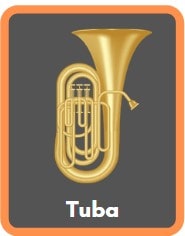
There is normally just one tuba in an orchestra and also it generally plays harmony tones.
It is played by sitting down with the instrument on your lap and the bell encountering up. The player blows and hums into a huge mouthpiece while using the hand to press down on the valves which changes the sound.
Tubas range in size from 9 to 18 feet, the longer they are, the lower they seem. Constructed from around 16 feet of tubing, the tuba is the most affordable appearing participant of the brass family. The tuba has three to five shutoffs and is held upright in the gamer’s lap.
Percussion Instruments

The last part of the family instrument group of a band is percussion.
The majority of percussion players become acquainted with playing numerous instruments since this classification is comprised of a lot of various alternatives as well as each music makes use of various combinations of instruments.
Snare drums, bass drums, cymbals, xylophones, and also even chimes become part of such a family of instruments.
Percussion instruments consist of any type of instrument that makes a sound when it is hit, drunk, or scuffed. It’s hard to be a percussionist because it takes a great deal of practice to strike an instrument with the right amount of toughness, in the ideal area, and at the right time.
Some percussion instruments are tuned and also can seem too different notes, like the xylophone, timpani, or piano, as well as some, are untuned without any certain pitch, like the bass drum, cymbals, or castanets.
Percussion instruments keep the rhythm, make special sounds as well as add excitement as well as shade. Unlike most of the various other members in a band or orchestra, a percussionist will typically play many different instruments unharmed by music.
One of the most typical percussion instruments in the orchestra includes the timpani, xylophone, cymbals, triangle, snare drum, bass drum, tambourine, maracas, gongs, chimes, celesta, as well as piano.
Drums
Drums are the oldest instruments on earth, dating back thousands of years to the moment of cavemen. The way that a snare drum works is right, you can take those snares off and get a different sound.
When you have a standard understanding of snare drum as well as a basic understanding of balanced principles, you’ll have the ability to play any of these percussion instruments. The bell package is a keyboard instrument and just how to play the bell set and also have a standard understanding of just how to review songs. You can play any kind of keyboard instrument, a marimba vibraphone.

Snare Drum
The snare drum is a small drum made of timber or brass with drumheads made from calfskin or plastic stretched over both ends of a hollow cylinder. It has a set of wire-wrapped strings stretched throughout the bottom head (the snare), which offers the snare drum its unique “rattling” sound when the drum is hit.
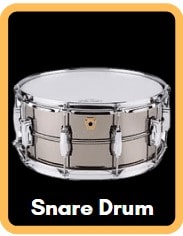
A tiny switch on the side of the drum permits the player to turn the snare on or off depending upon the demands of the item. The snare drum is untuned, so it doesn’t appear distinctive pitches. It is frequently used in armed forces songs and also is a central part of any kind of marching band. Snare drums are used to keep the rhythm and make special sounds, such as drumrolls. You play the snare drum by hitting the top with drumsticks, mallets, or brushes.
Frequently Asked Questions About Band Instruments
How Many Instruments Are in a Band?
The number of instruments that are in a band, will depend on the size of the band and if it is a typical school band, marching band, or concert band. Normally there are 14 band instruments, divided into three sections:
– WOODWIND: Clarinets, Flutes, Saxophones, Piccolos, Oboes, Bassoons
– BRASS: Trombones, Trumpets, Tubas, French Horns, Baritones
– PERCUSSION: Snare Drums, Bell Kit, Bass Drums
Our Most Popular Articles About Band Instruments
- Popular School Band Instruments ✨
- Easiest Band Instruments ✅
- 5th Grade Band Instruments 🧒
- The Cheapest Band Instruments 💰
- The Most Expensive Band Instruments 💸
- Hardest Instruments to Play 🥵
- Middle School Band Instruments 🤓
- Plastic Band Instruments 🚩
Nice round-up of what instruments make up a band! I’ve also liked your other article about the benefits children gain…